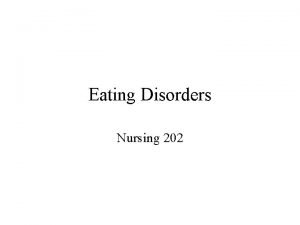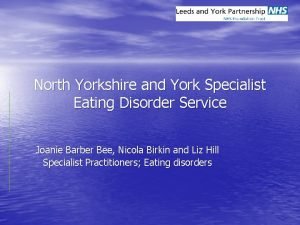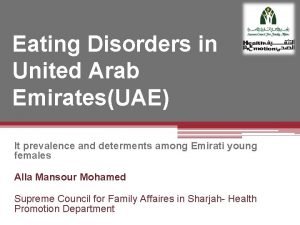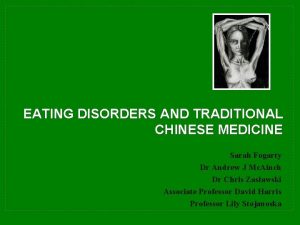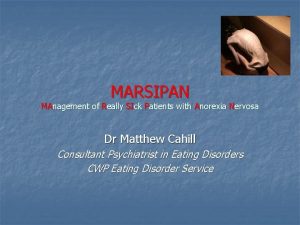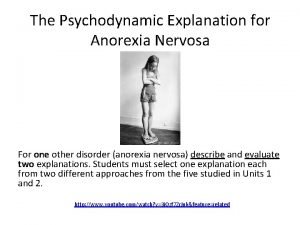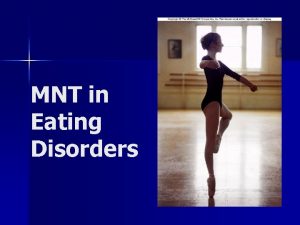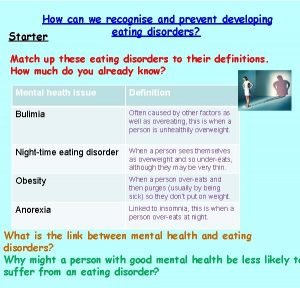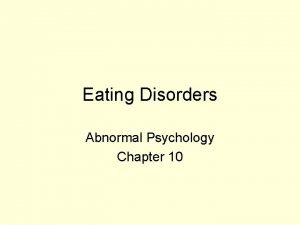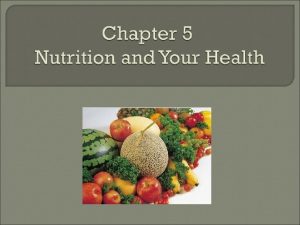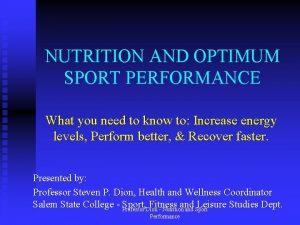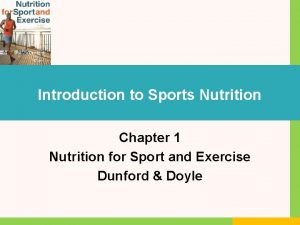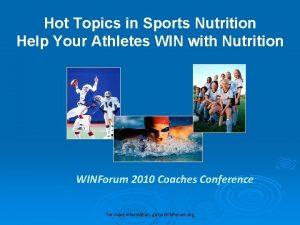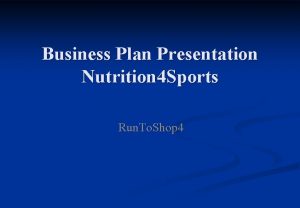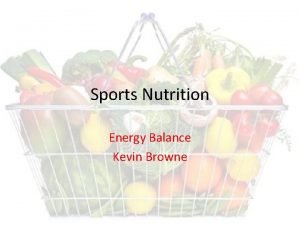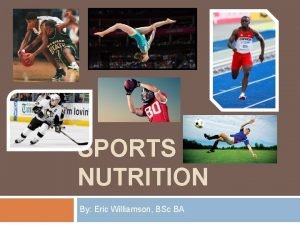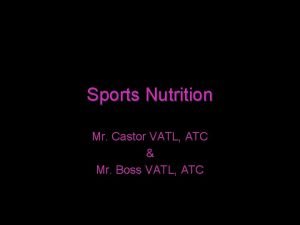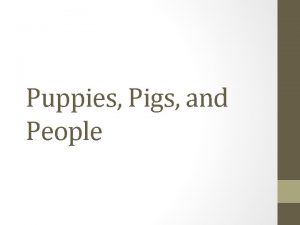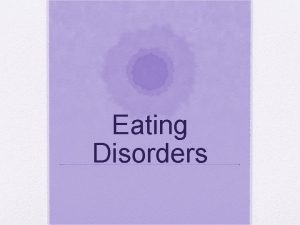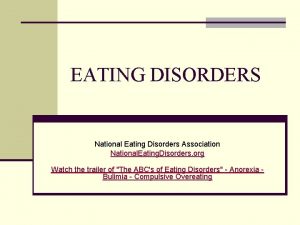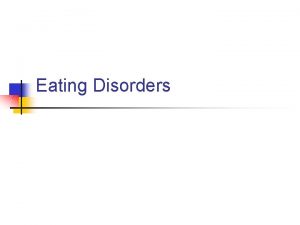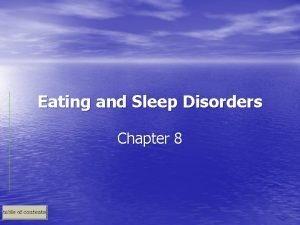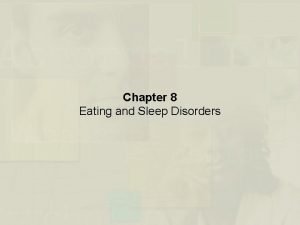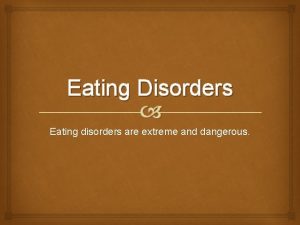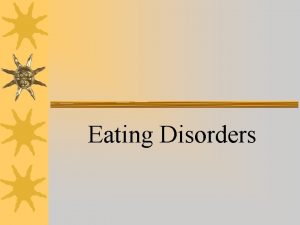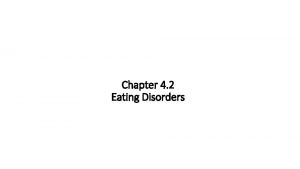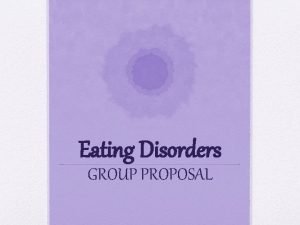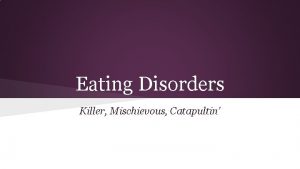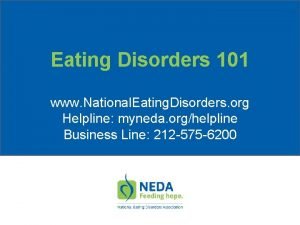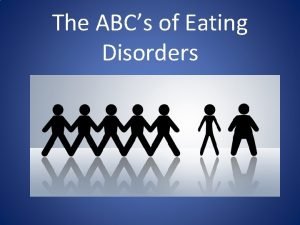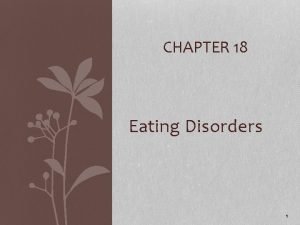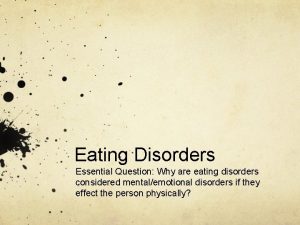Sports Nutrition Ch 14 and Eating Disorders Ch






















- Slides: 22

Sports Nutrition (Ch. 14) and Eating Disorders (Ch. 15) March 2015

Key Skills • Identify major benefits of exercise. • Distinguish between anaerobic and aerobic metabolism in exercise (without oversimplifying) • Discuss how exercise affects our carbohydrate, fat, protein, and water/electrolyte needs. • Explain how and when people should eat for exercise. • Distinguish between the types of anorexia nervosa and bulimia nervosa. • Describe risk factors, health effects, and treatment strategies for eating disorders.

Why Exercise? What are the main reasons that people exercise, in your experience? Is it possible for exercise to be an unhealthy habit? Explain briefly.

Benefits of Exercise Cardiovascular Psychological Fat/Muscloskeletal Raises HDL, lowers atherosclerosis risk Reduces anxiety; endorphins improve mood Reduces fat Reduces risk of hypertension, stroke, and diabetes Helps sleep quality Maintains and builds muscle Lowers resting heart rate Improves self-esteem Makes bones stronger and reduces osteoporosis risk

Agree or Disagree? “When trying to build muscle, you should perform high-intensity exercise. When trying to lose/maintain weight, you should perform longer periods of low-intensity aerobic exercise. ” Agree or disagree, and why?

Exercise and Weight Exercise helps with weight maintenance: • Directly burns calories (to provide energy for movement) • Raises metabolic rate (since muscle burns more calories than fat) • Low-intensity exercise uses mostly fat for energy, and high-intensity exercise uses mostly glycogen, but… • …either way, exercise increases calories out, so both low- and high-intensity exercise can help you lose weight!

Choosing Exercise Intensity • • • High-intensity exercise can be more taxing, but does not take as long as low-intensity exercise to burn calories. For good cardiovascular health, moderate exercise 3 -5 times a week is recommended, 20 -60 minutes depending on intensity and weight. Moderate = 55 -70% of agepredicted maximum heart rate. Agepredicted maximum heart rate = 220 bpm – age. So a 30 -year-old’s maximum heart rate is 190 bpm, and moderate exercise for them would be ~105 – 133 bpm.

Exercising for Muscle-Building • • There is no single way to build muscle. There are many different muscle groups and ways to train them! Repeated, regular, gradually escalating exercise is better than forcing yourself past your limit. It’s important to stretch and warm up to prevent injury and reduce soreness. Begin with light exercise and thorough, but not forced, stretching on both sides. Hold stretches, don’t “yank” your body into place. Be especially careful with the neck!

Aerobic vs. Anaerobic Exercise What is the difference between aerobic and anaerobic exercise? Classify the following exercises as mainly aerobic or anaerobic (or another category of your choice if you do not think either term describes them well enough): Weightlifting Long-distance swimming Short-distance (50 m) swimming for speed

Exercise and Energy Systems • Our muscles have a small amount of stored ATP available, as well as a small amount of phosphocreatine (PC), another energy storage molecule. These reserves get used up very quickly during intense activity. • In intense exercise, we tend to use more anaerobic respiration, as the energy demands of muscles exceed the oxygen supply for making ATP. Instead, muscles do lactic acid fermentation. • During longer-term exercise, aerobic respiration kicks in and we use oxygen to make ATP. This is less fatigue-inducing. • We can and do use more than one pathway at once in different muscle types!

Caloric Needs • High physical activity increases our caloric demands. Depends on weight and activity level. • Athletes often do better eating many smaller meals, rather than a few large ones, allowing them to keep their blood sugar up. • Athletes need enough protein to maintain muscle mass and enough carbohydrates to maintain blood sugar. • Although athletes often try to gain weight, this should be done gradually! ½ pound a week is a good rate for many.

Carbohydrate Needs • For endurance athletes, eating foods that are rich in carbohydrates in a pre-exercise meal (carb-loading 4 hours before exercise) can improve performance. When eating directly before exercising, foods that raise blood sugar can be helpful, but beware of “hitting the wall. ” • Assuming you have adequate carbohydrate reserves, your stored glycogen will last for 60 -90 minutes of exercise if you don’t eat or drink any carbohydrate sources. For many people, sports drinks containing sugar and electrolytes, or a homemade substitute, can help. • Do not cut carbs excessively if you’re an athlete. While it is possible to provide energy needs with a high protein diet, protein is not metabolizes as efficiently. • It’s also important to replenish carbs and protein after exercise with a balanced meal.

Protein Needs • Protein is not a great energy source due to the time it takes to metabolize, but it’s important for muscle building and repair. We break down and build protein after exercise! • Athletes may need double the RDA for protein… though most Americans already get this much! • Vegetarians can get enough protein for exercise if they use protein complementation. • Supplements can help in some cases, but as we discussed in chapter 11, a balanced diet will do fine.

Water and Electrolyte Needs • Even in cold weather, we lose water when exercising – especially if the air is dry. • As we saw earlier, dehydration and electrolyte loss are both dangerous. • Drink plenty of water and electrolytes, with some sugar if exercising a long time. Just drinking water alone does not replace lost potassium and sodium. • This is especially important for prolonged exercise.

Exercise, Steroids, and Eating Disorders • Some people suffer from body dysmorphic disorders, a very negative image of their own bodies. Men can get these as well. Muscle dysmorphia can lead to steroid abuse and its side effects, such as heart disease, behavior changes, and sterility. • In female athletes, the female athlete triad of amenorrhea, osteoporosis, and disordered eating can combine to result in bone damage.

True or False? Bulimics are people who eat and then throw up. Anorexics are people who refuse to eat.

Types of Bulimia Nervosa • • Bulimia nervosa is when a person takes in a large amount of food regularly, then engages in compensatory activity, such as purging or exercise to cope with stress/guilt/etc. Different from bingeeating disorder, which doesn’t involve compensatory behavior. Not all bulimics induce vomiting! Purging type: Use enemas, vomiting, and/or laxatives Non-purging: Uses fasting or exercise.

Bulimia Nervosa and Health

Types of Anorexia Nervosa • • Anorexia nervosa is when a person reduces their body weight to <85% of a healthy weight for psychological reasons. Sometimes overexercises. Often seen with amenorrhea. Restricting anorexia: Doesn’t bingeeat/purge. Binge-eating/purging anorexia: In addition to believing themselves overweight even though underweight, there are purging behaviors. Not all disorders fit the anorexia or bulimia patterns. EDNOS: Eating Disorder Not Otherwise Specified.

Anorexia Nervosa and Health

Risk Factors for Eating Disorders • Low self-image (depression, body dysmorphia) • Stress • Social pressures and cultural influences/unrealistic expectations • Teasing • Crash dieting • Be wary of stereotypes. Although there are somewhat higher levels of anorexia nervosa in non. Hispanic whites, there are similar prevalences of most other eating disorders across ethnicities!

Prevention and Treatment • Preventing eating disorders is challenging, and treating them even more so. • Ideals of body weight are formed early, and hard to shift (“thinness schema. ”) • Treatment is multidisciplinary – requires psychological support, nutritional support, behavioral approaches, and patience. • Things you can do: Respect diverse body types, be a good role model, be supportive • Things not to do: Do not treat weight and foods as morally (rather than nutritionally) good and bad, overcriticize, or enable.
 Chapter 18 eating and feeding disorders
Chapter 18 eating and feeding disorders Hypothalamus and eating disorders
Hypothalamus and eating disorders Eating disorder in which people overeat compulsively
Eating disorder in which people overeat compulsively Yorkshire centre for eating disorders
Yorkshire centre for eating disorders Eating disorders in uae
Eating disorders in uae Sarah fogarty
Sarah fogarty Chimps eating termites
Chimps eating termites Isabelle caro
Isabelle caro Psychodynamic approach to eating disorders
Psychodynamic approach to eating disorders How to be anorexic
How to be anorexic How to spot eating disorders
How to spot eating disorders Kate moss anorexia
Kate moss anorexia Chapter 5 nutrition guidelines tools for healthful eating
Chapter 5 nutrition guidelines tools for healthful eating It is a popular indoor and outdoor sport
It is a popular indoor and outdoor sport Optimum sports performance
Optimum sports performance Definition of sports nutrition
Definition of sports nutrition Current topics in sports nutrition
Current topics in sports nutrition Sports nutrition business plan
Sports nutrition business plan Energy balance in sport
Energy balance in sport Am i fat
Am i fat Mr sport nutrition
Mr sport nutrition Puppies, pigs, and people: eating meat and marginal cases
Puppies, pigs, and people: eating meat and marginal cases Health and social care level 3 unit 14
Health and social care level 3 unit 14

